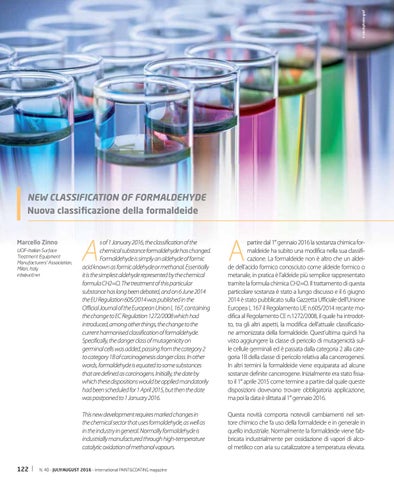© stockphoto-graf
NEW CLASSIFICATION OF FORMALDEHYDE Nuova classificazione della formaldeide
Marcello Zinno UCIF-Italian Surface Treatment Equipment Manufacturers’ Association, Milan, Italy info@ucif.net
122
s of 1 January 2016, the classification of the chemical substance formaldehyde has changed. Formaldehyde is simply an aldehyde of formic acid known as formic aldehyde or methanal. Essentially it is the simplest aldehyde represented by the chemical formula CH2=O. The treatment of this particular substance has long been debated, and on 6 June 2014 the EU Regulation 605/2014 was published in the Official Journal of the European Union L 167, containing the change to EC Regulation 1272/2008 which had introduced, among other things, the change to the current harmonised classification of formaldehyde. Specifically, the danger class of mutagenicity on germinal cells was added, passing from the category 2 to category 1B of carcinogenesis danger class. In other words, formaldehyde is equated to some substances that are defined as carcinogens. Initially, the date by which these dispositions would be applied mandatorily had been scheduled for 1 April 2015, but then the date was postponed to 1 January 2016.
A
partire dal 1° gennaio 2016 la sostanza chimica formaldeide ha subito una modifica nella sua classificazione. La formaldeide non è altro che un aldeide dell’acido formico conosciuto come aldeide formico o metanale, in pratica è l’aldeide più semplice rappresentato tramite la formula chimica CH2=O. Il trattamento di questa particolare sostanza è stato a lungo discusso e il 6 giugno 2014 è stato pubblicato sulla Gazzetta Ufficiale dell’Unione Europea L 167 il Regolamento UE n.605/2014 recante modifica al Regolamento CE n.1272/2008, il quale ha introdotto, tra gli altri aspetti, la modifica dell’attuale classificazione armonizzata della formaldeide. Quest’ultima quindi ha visto aggiungere la classe di pericolo di mutagenicità sulle cellule germinali ed è passata dalla categoria 2 alla categoria 1B della classe di pericolo relativa alla cancerogenesi. In altri termini la formaldeide viene equiparata ad alcune sostanze definite cancerogene. Inizialmente era stato fissato il 1° aprile 2015 come termine a partire dal quale queste disposizioni dovevano trovare obbligatoria applicazione, ma poi la data è slittata al 1° gennaio 2016.
This new development requires marked changes in the chemical sector that uses formaldehyde, as well as in the industry in general. Normally formaldehyde is industrially manufactured through high-temperature catalytic oxidation of methanol vapours.
Questa novità comporta notevoli cambiamenti nel settore chimico che fa uso della formaldeide e in generale in quello industriale. Normalmente la formaldeide viene fabbricata industrialmente per ossidazione di vapori di alcool metilico con aria su catalizzatore a temperatura elevata.
N. 40 - JULY/AUGUST 2016 - international PAINT&COATING magazine
A
